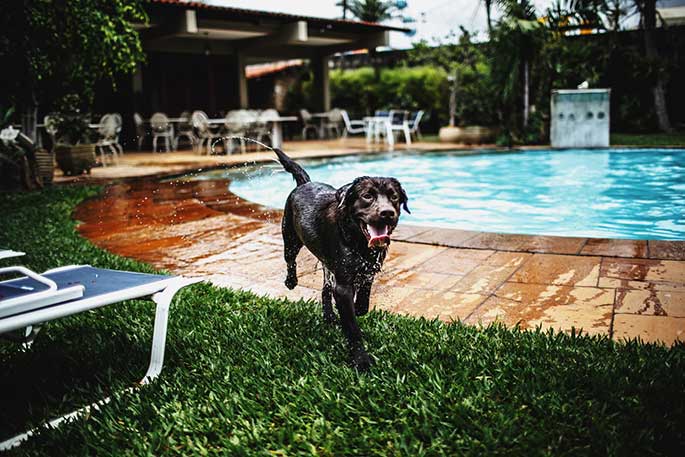
Nowadays, you can’t surprise anyone with special conditions created for pets. Restaurants, beauty salons, hotels, fitness centers are just some of the places where pets will feel comfortable. Dog pool is another trend that is gaining popularity among the owners of the quadruped.
Distinctive Features Of A Dog Pool
It’s no secret that dogs like to swim anytime and anywhere. In summer, swimming in a pool saves from the heat and helps to maintain physical activity. But what to do in the cold season? That’s when dog pools, which can be visited at any convenient time, as well as recover from injuries or illness, may help. Artificial plastic pools for dogs needs to have specific features. The cleaning system includes sand filters and pumps. Their task is to effectively clean the water and the pool walls, keeping the fur, bacteria, animal waste, chlorine, and chemical impurities that can damage the dog’s skin, away.
You can have a dog pool in your summer residence or in your backyard. According to the information as written here, the water reservoir is a single construction that allows owners to locate it on their own: above the ground, built-in completely or half, to ensure the smooth entry and exit of the animal from the pool. Remember that an inflatable dog pool is not a good idea, since it may be damaged by a dog’s claws. This should be a frame solid structure that can withstand claws and teeth. There are bone-shaped or pawprint-shaped containers available. Plastic pools for dogs are made of non-toxic materials and in various sizes.
The water in the pool goes through the same cleaning, heating, and treatment cycle as in a traditional pool. PH level monitoring is not necessary. Otherwise, dog water bodies are the same as human water bodies. The water inlets are located on the walls of the pool and the water outlet is on the floor. Sometimes dogs are prescribed to swim in warm water, as cold water can cause vessels to narrow which, in turn, reduces blood flow and makes muscles less flexible. In this case, an additional heating system is installed. The entering is performed from a dog ramp, and for non-ambulant or sick dogs there has to be a special lift. Vitality can be rejuvenated with the help of specially built in nozzles or equipment that simulates the oncoming current.
Some hydrotherapy pools are also equipped with an additional complex, where, after the basic physiotherapeutic procedures, a dog receives a therapy session. Being in a fixed position, the dog is affected by pulsating hot water jets which soothes sick muscles and speeds up the recovery process. In the pool, there are special places for hydrotherapy.
Water treadmills are widespread as well. They have advantages over “land” simulators because they relieve the pressure from a dog’s joints.
Indications For Rehabilitation In The Pool
Many dogs have to swim in the pool for medical reasons. This is a good way to recover and improve their health in the following cases:
- Injuries, fractures, bone surgery;
- Spinal problems (discopathy or discospondylitis);
- Prolonged illness and lack of movement (strengthening core muscles);
- Joint disorders;
- Dog racing, shows, sledding, agility and hunting season;
- Weight loss.
In a special hydrotherapy dog pool, rehabilitation is supervised by a physiotherapist who provides support and control over bathing. An “aqua-coach” selects special exercises aimed at strengthening a problematic zone. Hydrotherapy is indicated 7-12 days after surgery. In the pool, it is necessary to perform rehabilitation according to an individual program, based on the goals and indications.
Prepare For Swimming
Before swimming, a dog must be examined by a veterinarian, an ECG procedure should be performed and a UV lamp can be used to detect ringworm in the dog. A dog should enter the pool bathed. Hygiene procedures are performed either at home or at a rehabilitation center (in a special life jacket). There are some recommendations to consider before swimming:
- Set clear goals that you want to achieve from going to the pool. An instructor or physiotherapist can help;
- You should have your paperwork, certificates, and doctor’s reports with you when it comes to recovery activities;
- You can’t feed your dog 2-3 hours before swimming;
- If your pet has a favorite toy at home, you can take it with you. This will help it feel more confident and courageous.
It’s important that your dog gets used to it in an unusual environment, otherwise, it’ll just refuse to get into the water or, even worse, bite the instructor.
Features And Duration Of The Procedure
The recovery measures should begin as soon as possible because this prevents complications. The individuality of rehabilitation procedures depends on age, disease, injury locations, and concomitant health problems in the animal.
The rehabilitation course is divided into 3 stages.
- Initial: Carried out from the moment of surgical intervention and lasts 14 days after surgery;
- Partial: Recovery of the dog from the moment of suture release to full steady load;
- Training and rehabilitation: Begins with the development of the musculoskeletal system and ends with full functional rehabilitation.
Recovery includes hydrotherapy (hydro-massage, swimming, water exercises) and passive rehabilitation (massage, physiotherapy, therapeutic baths, and light therapy).
Duration of the procedure depends on the indication of the doctor and special aspects of a disease. First sessions are usually not longer than 20 minutes. Subsequently, time and load can be adjusted.
Ways To Avoid Hypothermia After The Procedure
Dogs, especially short-haired dogs, must be dried with a special hair dryer after water treatment. Special attention is paid to the ears, as the water they contain can cause serious inflammation. In cold weather, it is recommended to put on a hat and special coverall or blanket to avoid hypothermia.
Contraindications
Swimming is not always a panacea for everyone under any circumstances. Contraindications for a dog’s swimming in the pool include:
- Cardiopulmonary diseases;
- Skin parasites;
- Open wounds and skin diseases;
- infectious diseases;
- Acute joint inflammation;
- Malignant tumors;
- Ear and eye inflammation;
- Hypersensitivity to chlorine;
- Heat.
In any case, if there are no contraindications, swimming will do more good than harm. In addition to rehabilitation, your pet will be able to keep itself in good physical shape. Water treatments will help prepare your dog for competitions and exhibitions, develop its grace and smooth movement.



